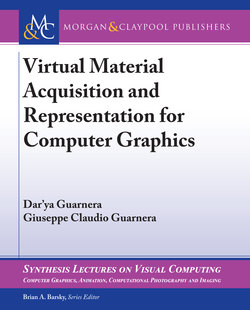Читать книгу Virtual Material Acquisition and Representation for Computer Graphics - Dar'ya Guarnera - Страница 7
На сайте Литреса книга снята с продажи.
ОглавлениеContents
Preface
Acknowledgments
1 Introduction
1.1 Challenges
1.2 Scope of the Book
2 Reflectance Functions
2.1 Definition of the BRDF
2.2 Basic BRDF Models
3 Models of BRDF
3.1 Phenomenological Models
3.1.1 Phenomenological Models for Isotropic Materials
3.1.2 Phenomenological Models for Anisotropic Materials
3.2 Physically Based Models
3.2.1 Physically Based Models for Isotropic Materials
3.2.2 Physically Based Models for Anisotropic Materials
3.3 Data-Driven Models
3.3.1 Data-Driven Models for Isotropic Materials
3.3.2 Data-Driven Models for Anisotropic Materials
3.4 Available Resources for BRDF Data Fitting and Visualisation
4 Acquisition Setups
4.1 Gonioreflectometers
4.2 Image-Based Measurement
4.3 Catadioptric Measurement Setups
4.4 Spherical and Hemispherical Gantry
4.5 LCD Light Source
4.6 Flash Illumination and Other Capture Setups
5 Conclusion
5.1 Conclusion
Bibliography
Authors’ Biographies
